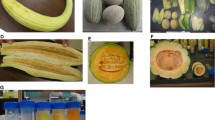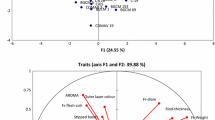Summary
A cross was made between a unique highly branched, early flowering line, U. S. Department of Agriculture (USDA) 846-1 (P1; 7 to 11 lateral branches), and ‘Topmark’ (P2; 2 to 4 lateral branches), a U.S. Western Ship** melon, to produce an array of 119 F3 families. Subsequently, a genetic analysis was conducted at Arlington and Hancock, Wisconsin in 2001 to evaluate the segregating progeny for factors likely involved in yield-formation, including days to anthesis, percentage of plants with early pistillate flowering, primary branch number, fruit number and weight per plant, average weight per fruit, percentage of plants with predominantly crown fruit set, and percentage of plants with early maturing fruit. Although, genotype × environment (G × E) interactions were important for some traits (e.g., fruit number and fruit weight), considerable additive and/or dominance variance was detected for all traits. This research provides critical data associated with highly branched melon germplasm including trait correlations and heritabilies (broad- and narrow-sense ranged between 0.28 and 0.91) that used judiciously will allow the development high yielding melon cultivars with early, basally concentrated fruit suitable for once-over or machine harvesting operations.
Access this article
We’re sorry, something doesn't seem to be working properly.
Please try refreshing the page. If that doesn't work, please contact support so we can address the problem.
Similar content being viewed by others
Abbreviations
- AWF:
-
average weight per fruit
- BLUE:
-
best linear unbiased estimation
- BLUP:
-
best linear unbiased prediction
- DA:
-
days to anthesis
- FN:
-
fruit number per plant
- FW:
-
fruit weight per plant
- PB:
-
primary branch number
- PCF:
-
percentage of plants with predominantly crown fruit set
- PMF:
-
percentage of plants with early maturing fruit
- PPF:
-
percentage of plants with early pistillate flowering
References
Abdalla MMA, Aboul-Nasr MH, (2002) Estimation of heterosis for yield and other economical characters of melon (Cucumis melo L.) in upper Egypt. In: Maynard DN (ed). Proc. Cucurbitaceae 2002. Naples, Florida, December 8–12, 2002, ASHS, Alexandria, VA, p. 11–16
Austin DF Lee M (1996) Comparative map** in F2:3 and F6:7 generations of quantitative trait loci for grain yield and yield components in maize. Theor Appl Genet 92:817–826
Bernardo R (1996a) Best linear unbiased prediction of maize single-cross performance. Crop Sci 36:50–56
Bernardo R (1996b) Test cross additive and dominance effects in best linear unbiased prediction of maize single-cross performance. Theor Appl Genet 93:1098–1102
Bernardo R (1998) Predicting the performance of untested single crosses: trait and marker data. In: Lamkey KR, Staub JE (eds) Proc. of the plant breeding symposium: concepts and breeding of heterosis in crop plants, Nov. 3, 1998. Crop Science Society of America, Madison, WI
Bhella HS (1985) Response of muskmelon to within-row spacing. Indiana Acad Sci 94:99–100
Board JE, Kang MS, Bodrero ML (2003) Yield components as indirect selection criteria for late-planted soybean cultivars. Agron J 95:420–429
Castle WE (1921) An improved method of estimating the number of genetic factors concerned in cases of blending inheritance. Proc Natl Acad Sci USA 81:6904–6907
Cockerham CC (1954) An extension of the concept of partitioning hereditary variance for analysis of covariances among relatives when epistasis is present. Genetics 39: 859–882
Cockerham CC (1986) Modifications in estimating the numbers of genes for a quantitative trait character. Genetics 114:659–664
Comstock RE, Robinson HF (1948) The components of genetic variance in populations of biparental progenies and their use in estimating the average degree of dominance. Biometrics 4:254–266
Comstock RE, Robinson HF (1952) Estimation of average dominance of genes. In: Gowen HW (ed) Heterosis. Iowa State College Press, Ames, IA, pp 494–516
Davis GN, Meinert UGH (1965) The effects of planting spacing and fruit pruning on the fruits of PMR no. 45 cantaloupe. Proc Amer Soc Hort Sci 87:299–302
de Leon N, Coors JG, Kaeppler SM, Rosa GJM (2005) Genetic control of prolificacy and related traits in the golden glow maize population: I. Phenotypic evaluation. Crop Sci 45: 1361–1369
Dijkhuizen A, Staub JE (2003) Effects of environment and genetic background on QTL affecting yield and fruit quality traits in a wide cross in cucumber [Cucumis sativus L. × Cucumis hardwickii (R.) Alef.]. J New Seeds 4:1–3
Dudley JW, Moll RH (1969) Interpretation and use of heritability and genetic estimates in plant breeding. Crop Sci 9:257–262
F.A.O (1997) FAOSTAT Agricultural Database. http://www.apps.fao.org
F.A.O (1999) FAOSTAT Agricultural Database. http://www.apps.fao.org
Fazio G (2001) Comparative study of marker-assisted and phenotypic selection and genetic analysis of yield components in cucumber. Ph.D. Diss., University of Wisconsin, Madison
Griffing B (1956) A generalized treatment of the use of diallel crosses in quantitative inheritance. Heredity 10:30–50
Hallauer AR, Miranda JB (1988) Quantitative genetics and maize breeding. Iowa State University Press, Ames
Hughes DL, Bosland J, Yamaguchi M (1983) Movement of photosynthates in muskmelon plants. J Amer Soc Hort Sci 108:189–192
Kearsey MJ, Pooni HS (1996) The genetical analysis of quantitative traits, 1st edn. Chapman and Hall, London
Knavel DE (1988) Growth, development and yield potential of short internode muskmelon. J Am Soc Hort Sci 113:595–599
Kubicki B (1962) Inheritance of some characters in muskmelon (Cucumis melo L.). Genet Pol 3:265–274
Kultur F, Harrison HC, Staub JE, Palta JP (2001) Spacing and genotype effects on fruit sugar concentration and yield of muskmelon. HortScience 36:274–278
Lande R (1981) The minimum number of genes contributing to quantitative variation between and within populations. Genetics 99:541–553
Lippert LF, Hall MO (1982) Heritabilities and correlations in muskmelon from parent offspring regression analyses. J Am Soc Hort Sci 107:217–221
Lippert LF, Legg PD (1972) Diallel analysis for yield and maturity characteristics in muskmelon cultivars. J Am Soc Hort Sci 97:87–90
Littell RC, Milliken GA, Stroup WW, Wolfinger RD (1996) SAS system for mixed models. SAS Institute Inc. Cary, NC
Mather K, **ks JL (1982) Biometrical genetics, 3rd edn. Chapman and Hall, London
Maynard ET, Scott WD (1998) Plant spacing affects yield of ‘Superstar’ muskmelon. HortScience 33:52–54
McCreight JD Nerson H, Grumet R (1993) Melon, Cucumis melo L. In: Kalloo G, Bergh BO (eds) Genetic improvement of vegetable crops. Pergamon Press, New York
McGlasson WB, Pratt HK (1963) Fruit-set patterns and fruit growth in cantaloupe (Cucumis melo L. var. reticulatis Naud.). Proc Amer Soc Hort Sci 83:495–505
Mendlinger S (1994) Effects of increasing plant density and salinity on yield and fruit quality in muskmelon. Sci Hort 57:41–49
Mohr HC, Knavel DE (1966) Progress in the development of short-internode (bush) cantaloupes. HortScience 1:16
N.A.S.S (2003) USDA economic and statistic system. http://www.usda.gov/nass Natl. Agr. Stat. Serv. USA
Nerson H, Paris HS, Karchi Z (1983) Characteristics of birdnest-type muskmelons. Sci Hortic 21:341–352
Nerson H, Paris HS (1987) Effects of plant type and growth regulators on the flowering, fruiting and yield concentrated of melon. Crop Res 27:19–30
Paris HS, Karchi Z, Nerson H, Govers A, Freudenberg D (1981) A new plant type in Cucumis melo L. Cucurbit Genet. Coop Rpt 4:24–26
Paris HS, Karchi Z, Nerson H, Burger Y (1982) On the compact appearance of birdnest type muskmelons. HortScience 17:476
Paris HS, Nerson H, Karchi Z (1984) Genetics of internode length in melons. J Hered 75:403–406
Paris HS, McCollum TGM, Nerson H, Cantliffe DJ, Karchi Z (1985) Breeding for concentrated-yield muskmelons. J Hort Sci 60:335–339
Prusinkiewicz P, Haran J (1989) Lindenmayer systems, fractals, and plants. Springer-Verlag, New York
Quijada PA, Maureira IJ, Osborn TC (2004) Confirmation of QTL controlling seed yield in spring canola (Brassica napus L.) hybrids. Mol Breed 13:193–200
Robinson DC, Comstock RE, Harvey PH (1955) Genetic variances in open pollinated corn. Genetics 40:45–60
Robinson RW, Decker-Walters DS (1997) Cucurbits. Cab International, New York, NY
Rosa JT (1924) Fruiting habit and pollination of cantaloupe. Proc Amer Soc Hort Sci 21:51–57
SAS Institute, (1999) SAS version 8.02 for windows. SAS Institute Inc. Cary, NY
Septiningsih EM, Prasetiyono J, Lubis E, Tai TH, Tjubaryat T, Moeljopawiro S, McCouch SR (2003) Identification of quantitative trait loci for yield components in an advanced backcross population derived from the Oryza sativa variety IR64 and the wild relative O-rufipogon. Theor Appl Genet 107:1419–1432
Serquen FC, Bacher J, Staub JE (1997) Genetic analysis of yield components in cucumber at low plant density. J Am Soc Hort Sci 122:522–528
Smith AR (1984) Plants, fractals and formal languages. Comp Graph 18:1–10
Staub JE, Zalapa JE, Paris MK, McCreight J (2004) Selection for lateral branch number in melon (Cucumis melo L.). In: Lebeda A, Paris HS (eds). Proc. Cucurbitaceae 2004: The 8th Eucarpia meeting on cucurbit genetic and breeding. Olomuc, Czech Republic, July 12–17, 2004. Publisher, Palacky University in Olomuc, Czech Republic, pp 381–388
Taha M, Omara K, El Jack A (2003) Correlation among growth, yield, and quality characters in Cucumis melo L. Cucurbit Genet Coop Rpt 26:9–11
UWEX (2001) Commercial vegetable production in Wisconsin. University of Wisconsin-Extension. Cooperative Extension Publishing, Madison, WI
Vidal-Martinez VA, Clegg MD, Johnson BE (2001) Genetic studies on maize pollen and grain yield and their yield components. Maydica 46:35–40
Wright S (1968) Evolution and the genetics of populations. University of Chicago Press, Chicago, IL
Yadav B, Tyagi CS, Singh D (1998) Genetics of transgressive segregation for yield and yield components in wheat. Ann Appl Biol 133:227–235
Yan W, Rajcan I (2003) Prediction of cultivar performance based on single-versus multiple-year tests in soybean. Crop Sci 43:549–555
Zahara M (1972) Effects of plants density on yield and quality of cantaloupe. California Arg 26:15
Zalapa JE, Staub JE, McCreight J (2004) Genetic analysis of branching in melon (Cucumis melo L.). In: Lebeda A, Paris HS (eds). Proc. Cucurbitaceae 2004: The 8th Eucarpia meeting on cucurbit genetic and breeding. Olomuc, Czech Republic, July. 12–17, 2004. Publisher, Palacky University in Olomuc, Czech Republic, pp 373–380
Zalapa JE (2005) Inheritance and map** of plant architecture and fruit yield in melon (Cucumis melo L.). Ph.D. Diss., University of Wisconsin, Madison. (http://www.ars.esda.gov/mwa/madison/vcru)
Zalapa JE, Staub JE, McCreight J (2006) Generation means analysis of plant architectural traits and fruit yield in melon. Plant Breed 125:482–487
Zalapa JE, Staub JE, McCreight J, Chung SM, Cuevas H (2007) Detection of QTL for yield-related traits using recombinant inbred lines derived from exotic and elite U.S. Western Ship** melon germplasm. Theor Appl Genet 114:1185–1201
Acknowledgments
The authors gratefully acknowledge the Advance Opportunity Fellowship (AOF) at the University of Wisconsin-Madison, the National Consortium for Graduate Degrees for Minorities in Engineering and Science (GEM) fellowship, and the National Science Foundation K-Through-Infinity (KTI) fellowship for their support provided for graduate student training. Mention of trade name, proprietary product, or specific equipment does not constitute a guarantee or warranty by the USDA and does not imply its approval to the exclusion of other products that may be suitable.
Author information
Authors and Affiliations
Corresponding author
Rights and permissions
About this article
Cite this article
Zalapa, J.E., Staub, J.E. & McCreight, J.D. Variance component analysis of plant architectural traits and fruit yield in melon. Euphytica 162, 129–143 (2008). https://doi.org/10.1007/s10681-007-9622-0
Received:
Accepted:
Published:
Issue Date:
DOI: https://doi.org/10.1007/s10681-007-9622-0




